Digital Marketing Challenges Faced by Fashion Retailers: Debenhams
VerifiedAdded on 2020/10/05
|9
|2256
|207
Report
AI Summary
This report investigates the challenges of digital marketing faced by fashion retailers, using Debenhams as a case study. The research begins with an overview of digital marketing, its benefits, and the specific challenges encountered by fashion retailers, including cultural barriers, strategic issues, and competition. The study employs a descriptive research design, utilizing a qualitative approach with interviews of senior managers from Debenhams' fashion department. The literature review covers key aspects of digital marketing, such as the impact of social media, content creation, and the importance of adapting to global customer expectations. The research design includes the use of interpretivism philosophy and an inductive research approach. The report also addresses research accessibility, ethics, and an action plan for overcoming limitations. The findings aim to provide insights into how fashion retailers can enhance their digital marketing strategies, and to contribute to the existing body of knowledge on the subject.

Business Research methods
Paraphrase This Document
Need a fresh take? Get an instant paraphrase of this document with our AI Paraphraser
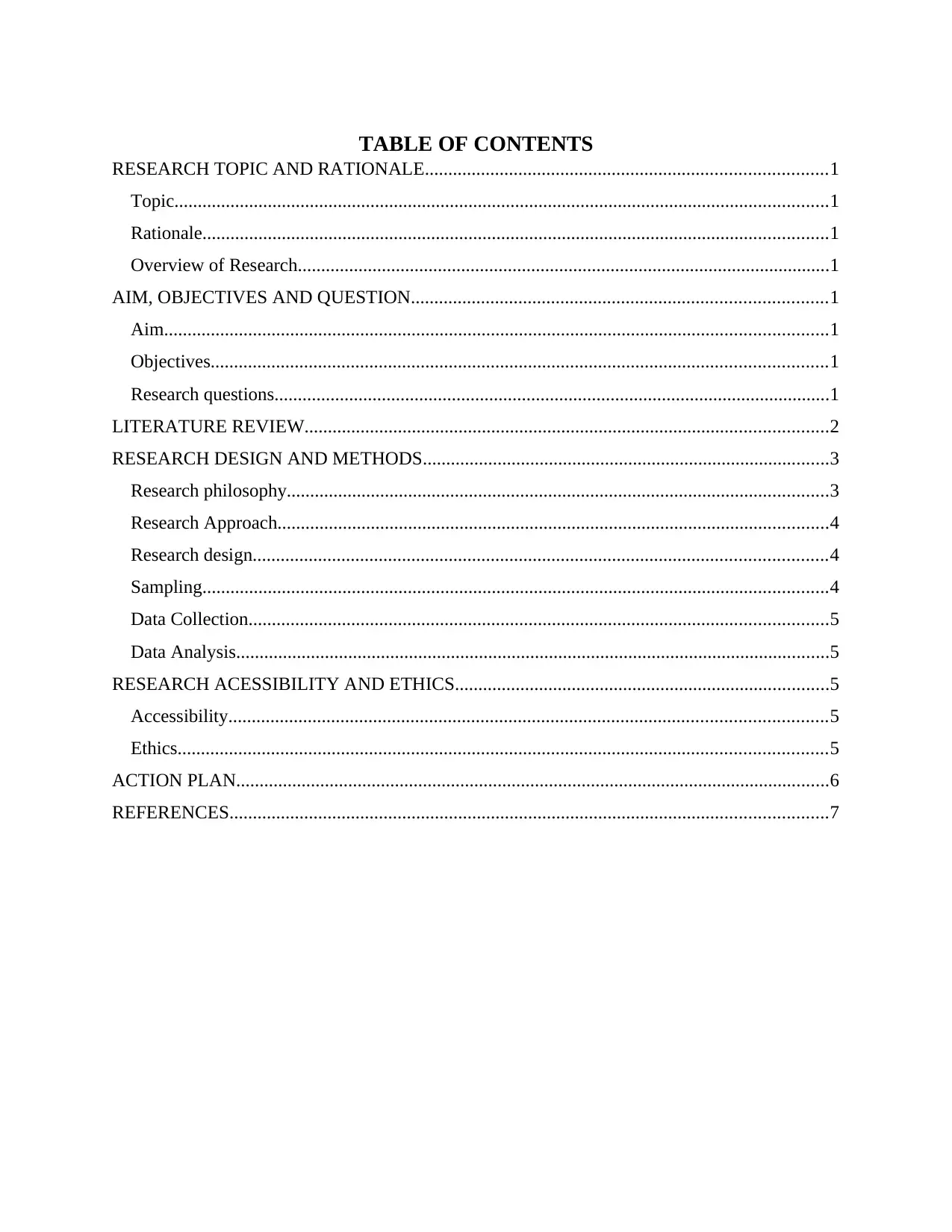
TABLE OF CONTENTS
RESEARCH TOPIC AND RATIONALE......................................................................................1
Topic............................................................................................................................................1
Rationale......................................................................................................................................1
Overview of Research..................................................................................................................1
AIM, OBJECTIVES AND QUESTION.........................................................................................1
Aim..............................................................................................................................................1
Objectives....................................................................................................................................1
Research questions.......................................................................................................................1
LITERATURE REVIEW................................................................................................................2
RESEARCH DESIGN AND METHODS.......................................................................................3
Research philosophy....................................................................................................................3
Research Approach......................................................................................................................4
Research design...........................................................................................................................4
Sampling......................................................................................................................................4
Data Collection............................................................................................................................5
Data Analysis...............................................................................................................................5
RESEARCH ACESSIBILITY AND ETHICS................................................................................5
Accessibility................................................................................................................................5
Ethics...........................................................................................................................................5
ACTION PLAN...............................................................................................................................6
REFERENCES................................................................................................................................7
RESEARCH TOPIC AND RATIONALE......................................................................................1
Topic............................................................................................................................................1
Rationale......................................................................................................................................1
Overview of Research..................................................................................................................1
AIM, OBJECTIVES AND QUESTION.........................................................................................1
Aim..............................................................................................................................................1
Objectives....................................................................................................................................1
Research questions.......................................................................................................................1
LITERATURE REVIEW................................................................................................................2
RESEARCH DESIGN AND METHODS.......................................................................................3
Research philosophy....................................................................................................................3
Research Approach......................................................................................................................4
Research design...........................................................................................................................4
Sampling......................................................................................................................................4
Data Collection............................................................................................................................5
Data Analysis...............................................................................................................................5
RESEARCH ACESSIBILITY AND ETHICS................................................................................5
Accessibility................................................................................................................................5
Ethics...........................................................................................................................................5
ACTION PLAN...............................................................................................................................6
REFERENCES................................................................................................................................7
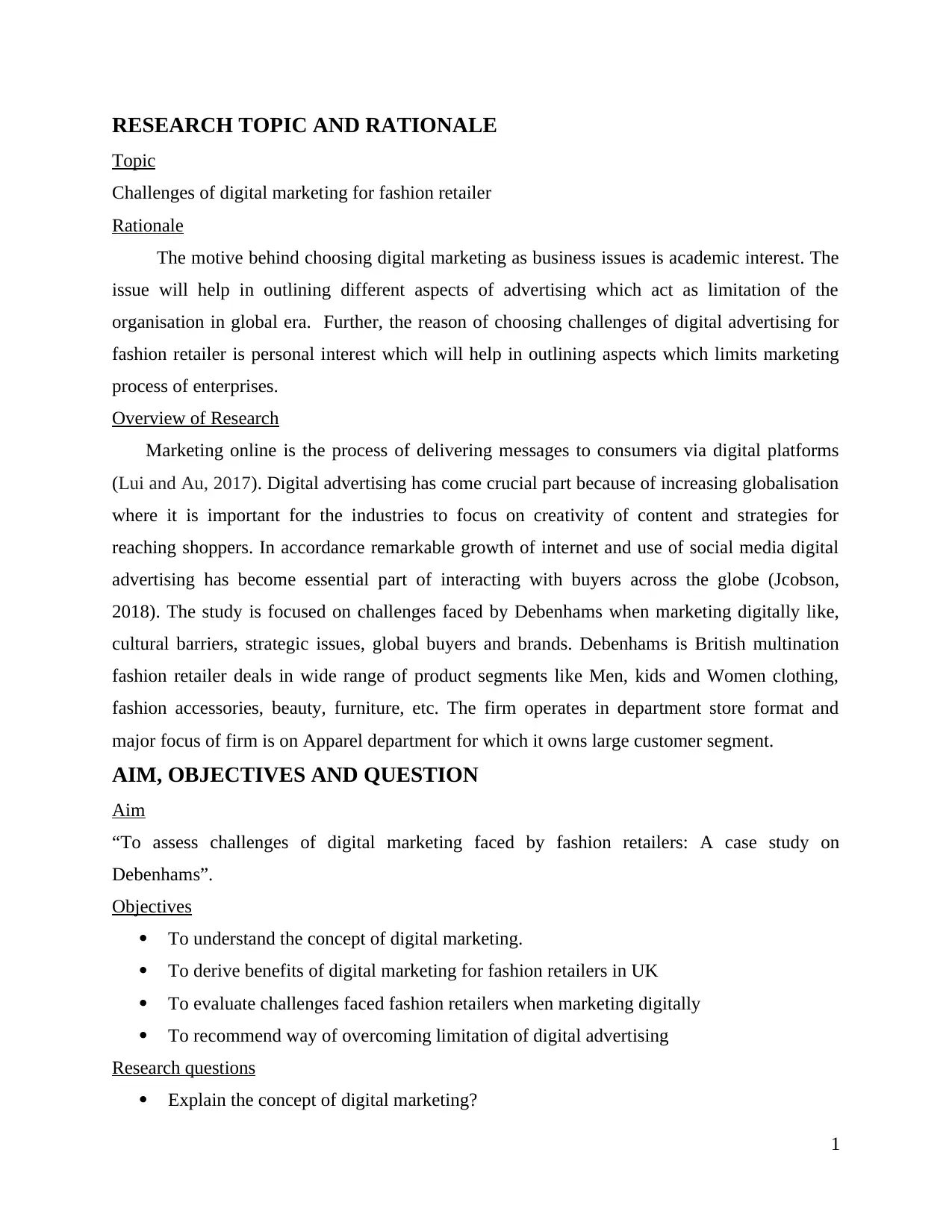
RESEARCH TOPIC AND RATIONALE
Topic
Challenges of digital marketing for fashion retailer
Rationale
The motive behind choosing digital marketing as business issues is academic interest. The
issue will help in outlining different aspects of advertising which act as limitation of the
organisation in global era. Further, the reason of choosing challenges of digital advertising for
fashion retailer is personal interest which will help in outlining aspects which limits marketing
process of enterprises.
Overview of Research
Marketing online is the process of delivering messages to consumers via digital platforms
(Lui and Au, 2017). Digital advertising has come crucial part because of increasing globalisation
where it is important for the industries to focus on creativity of content and strategies for
reaching shoppers. In accordance remarkable growth of internet and use of social media digital
advertising has become essential part of interacting with buyers across the globe (Jcobson,
2018). The study is focused on challenges faced by Debenhams when marketing digitally like,
cultural barriers, strategic issues, global buyers and brands. Debenhams is British multination
fashion retailer deals in wide range of product segments like Men, kids and Women clothing,
fashion accessories, beauty, furniture, etc. The firm operates in department store format and
major focus of firm is on Apparel department for which it owns large customer segment.
AIM, OBJECTIVES AND QUESTION
Aim
“To assess challenges of digital marketing faced by fashion retailers: A case study on
Debenhams”.
Objectives
To understand the concept of digital marketing.
To derive benefits of digital marketing for fashion retailers in UK
To evaluate challenges faced fashion retailers when marketing digitally
To recommend way of overcoming limitation of digital advertising
Research questions
Explain the concept of digital marketing?
1
Topic
Challenges of digital marketing for fashion retailer
Rationale
The motive behind choosing digital marketing as business issues is academic interest. The
issue will help in outlining different aspects of advertising which act as limitation of the
organisation in global era. Further, the reason of choosing challenges of digital advertising for
fashion retailer is personal interest which will help in outlining aspects which limits marketing
process of enterprises.
Overview of Research
Marketing online is the process of delivering messages to consumers via digital platforms
(Lui and Au, 2017). Digital advertising has come crucial part because of increasing globalisation
where it is important for the industries to focus on creativity of content and strategies for
reaching shoppers. In accordance remarkable growth of internet and use of social media digital
advertising has become essential part of interacting with buyers across the globe (Jcobson,
2018). The study is focused on challenges faced by Debenhams when marketing digitally like,
cultural barriers, strategic issues, global buyers and brands. Debenhams is British multination
fashion retailer deals in wide range of product segments like Men, kids and Women clothing,
fashion accessories, beauty, furniture, etc. The firm operates in department store format and
major focus of firm is on Apparel department for which it owns large customer segment.
AIM, OBJECTIVES AND QUESTION
Aim
“To assess challenges of digital marketing faced by fashion retailers: A case study on
Debenhams”.
Objectives
To understand the concept of digital marketing.
To derive benefits of digital marketing for fashion retailers in UK
To evaluate challenges faced fashion retailers when marketing digitally
To recommend way of overcoming limitation of digital advertising
Research questions
Explain the concept of digital marketing?
1
⊘ This is a preview!⊘
Do you want full access?
Subscribe today to unlock all pages.

Trusted by 1+ million students worldwide
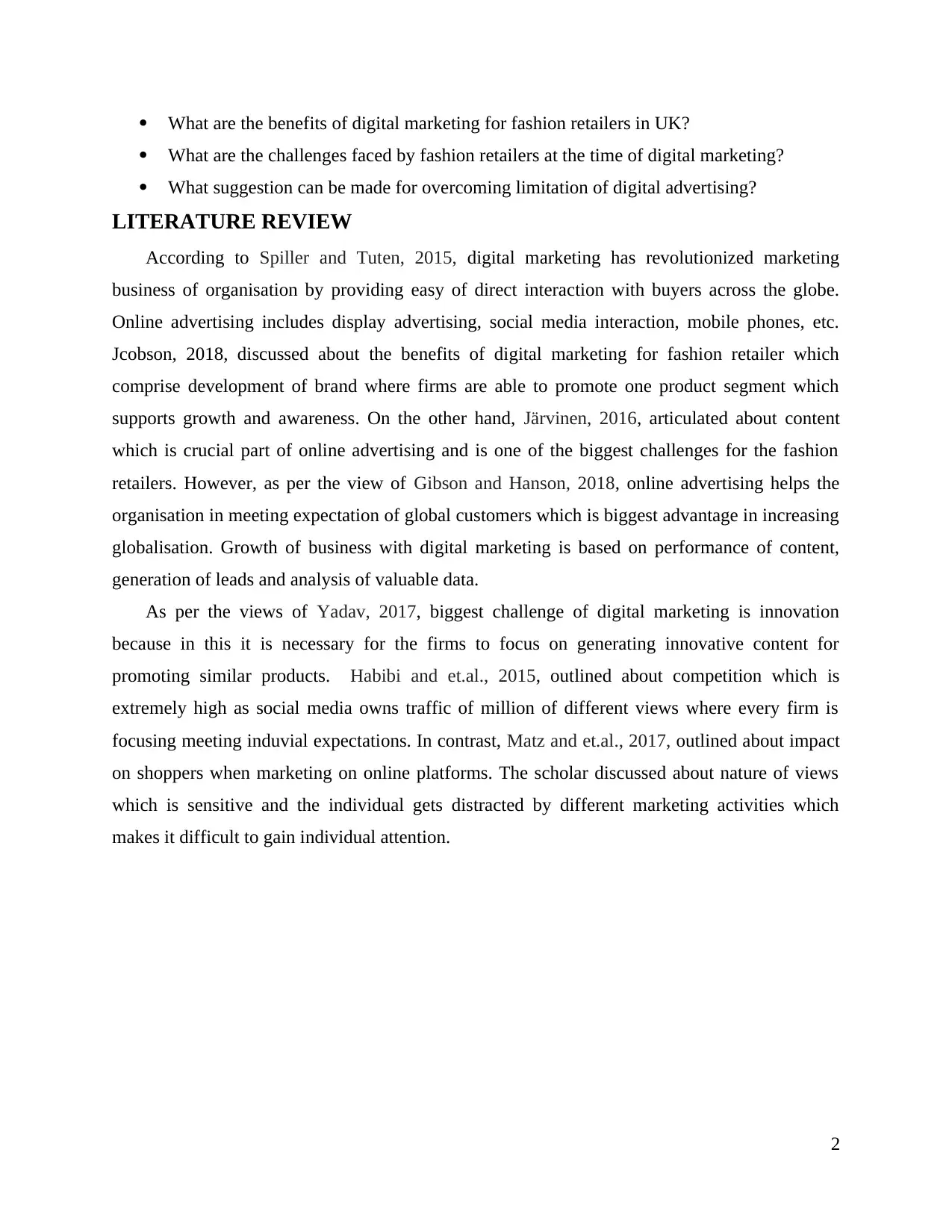
What are the benefits of digital marketing for fashion retailers in UK?
What are the challenges faced by fashion retailers at the time of digital marketing?
What suggestion can be made for overcoming limitation of digital advertising?
LITERATURE REVIEW
According to Spiller and Tuten, 2015, digital marketing has revolutionized marketing
business of organisation by providing easy of direct interaction with buyers across the globe.
Online advertising includes display advertising, social media interaction, mobile phones, etc.
Jcobson, 2018, discussed about the benefits of digital marketing for fashion retailer which
comprise development of brand where firms are able to promote one product segment which
supports growth and awareness. On the other hand, Järvinen, 2016, articulated about content
which is crucial part of online advertising and is one of the biggest challenges for the fashion
retailers. However, as per the view of Gibson and Hanson, 2018, online advertising helps the
organisation in meeting expectation of global customers which is biggest advantage in increasing
globalisation. Growth of business with digital marketing is based on performance of content,
generation of leads and analysis of valuable data.
As per the views of Yadav, 2017, biggest challenge of digital marketing is innovation
because in this it is necessary for the firms to focus on generating innovative content for
promoting similar products. Habibi and et.al., 2015, outlined about competition which is
extremely high as social media owns traffic of million of different views where every firm is
focusing meeting induvial expectations. In contrast, Matz and et.al., 2017, outlined about impact
on shoppers when marketing on online platforms. The scholar discussed about nature of views
which is sensitive and the individual gets distracted by different marketing activities which
makes it difficult to gain individual attention.
2
What are the challenges faced by fashion retailers at the time of digital marketing?
What suggestion can be made for overcoming limitation of digital advertising?
LITERATURE REVIEW
According to Spiller and Tuten, 2015, digital marketing has revolutionized marketing
business of organisation by providing easy of direct interaction with buyers across the globe.
Online advertising includes display advertising, social media interaction, mobile phones, etc.
Jcobson, 2018, discussed about the benefits of digital marketing for fashion retailer which
comprise development of brand where firms are able to promote one product segment which
supports growth and awareness. On the other hand, Järvinen, 2016, articulated about content
which is crucial part of online advertising and is one of the biggest challenges for the fashion
retailers. However, as per the view of Gibson and Hanson, 2018, online advertising helps the
organisation in meeting expectation of global customers which is biggest advantage in increasing
globalisation. Growth of business with digital marketing is based on performance of content,
generation of leads and analysis of valuable data.
As per the views of Yadav, 2017, biggest challenge of digital marketing is innovation
because in this it is necessary for the firms to focus on generating innovative content for
promoting similar products. Habibi and et.al., 2015, outlined about competition which is
extremely high as social media owns traffic of million of different views where every firm is
focusing meeting induvial expectations. In contrast, Matz and et.al., 2017, outlined about impact
on shoppers when marketing on online platforms. The scholar discussed about nature of views
which is sensitive and the individual gets distracted by different marketing activities which
makes it difficult to gain individual attention.
2
Paraphrase This Document
Need a fresh take? Get an instant paraphrase of this document with our AI Paraphraser
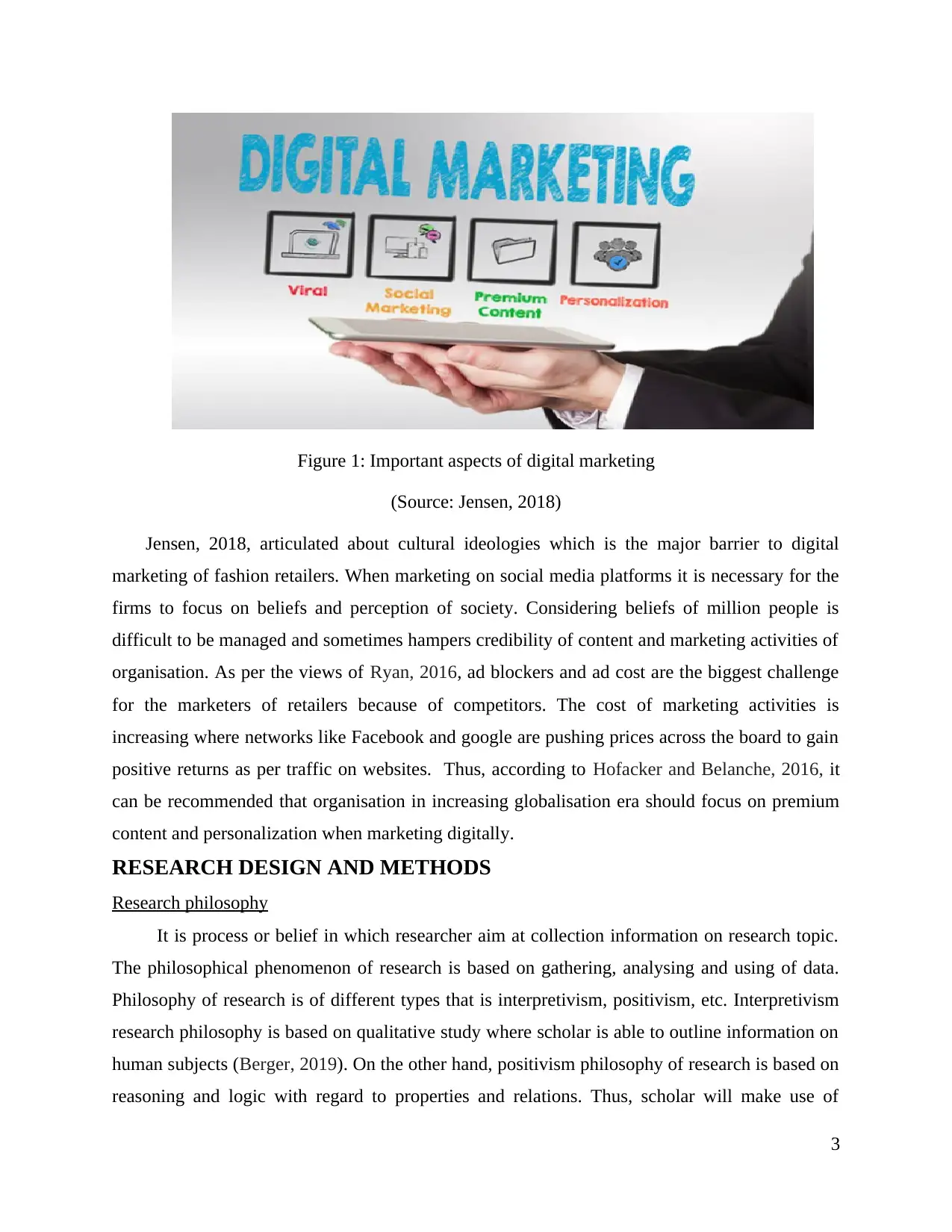
Figure 1: Important aspects of digital marketing
(Source: Jensen, 2018)
Jensen, 2018, articulated about cultural ideologies which is the major barrier to digital
marketing of fashion retailers. When marketing on social media platforms it is necessary for the
firms to focus on beliefs and perception of society. Considering beliefs of million people is
difficult to be managed and sometimes hampers credibility of content and marketing activities of
organisation. As per the views of Ryan, 2016, ad blockers and ad cost are the biggest challenge
for the marketers of retailers because of competitors. The cost of marketing activities is
increasing where networks like Facebook and google are pushing prices across the board to gain
positive returns as per traffic on websites. Thus, according to Hofacker and Belanche, 2016, it
can be recommended that organisation in increasing globalisation era should focus on premium
content and personalization when marketing digitally.
RESEARCH DESIGN AND METHODS
Research philosophy
It is process or belief in which researcher aim at collection information on research topic.
The philosophical phenomenon of research is based on gathering, analysing and using of data.
Philosophy of research is of different types that is interpretivism, positivism, etc. Interpretivism
research philosophy is based on qualitative study where scholar is able to outline information on
human subjects (Berger, 2019). On the other hand, positivism philosophy of research is based on
reasoning and logic with regard to properties and relations. Thus, scholar will make use of
3
(Source: Jensen, 2018)
Jensen, 2018, articulated about cultural ideologies which is the major barrier to digital
marketing of fashion retailers. When marketing on social media platforms it is necessary for the
firms to focus on beliefs and perception of society. Considering beliefs of million people is
difficult to be managed and sometimes hampers credibility of content and marketing activities of
organisation. As per the views of Ryan, 2016, ad blockers and ad cost are the biggest challenge
for the marketers of retailers because of competitors. The cost of marketing activities is
increasing where networks like Facebook and google are pushing prices across the board to gain
positive returns as per traffic on websites. Thus, according to Hofacker and Belanche, 2016, it
can be recommended that organisation in increasing globalisation era should focus on premium
content and personalization when marketing digitally.
RESEARCH DESIGN AND METHODS
Research philosophy
It is process or belief in which researcher aim at collection information on research topic.
The philosophical phenomenon of research is based on gathering, analysing and using of data.
Philosophy of research is of different types that is interpretivism, positivism, etc. Interpretivism
research philosophy is based on qualitative study where scholar is able to outline information on
human subjects (Berger, 2019). On the other hand, positivism philosophy of research is based on
reasoning and logic with regard to properties and relations. Thus, scholar will make use of
3
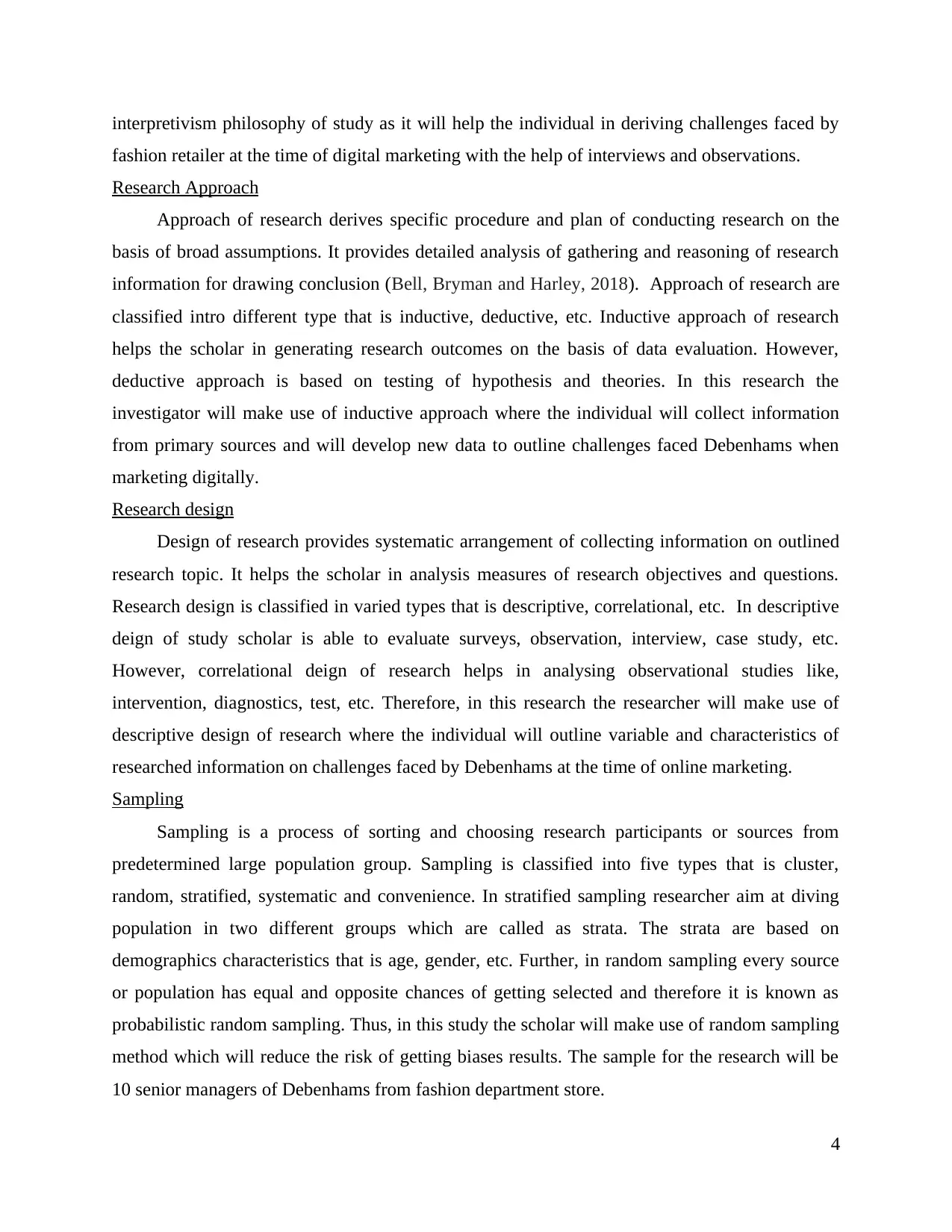
interpretivism philosophy of study as it will help the individual in deriving challenges faced by
fashion retailer at the time of digital marketing with the help of interviews and observations.
Research Approach
Approach of research derives specific procedure and plan of conducting research on the
basis of broad assumptions. It provides detailed analysis of gathering and reasoning of research
information for drawing conclusion (Bell, Bryman and Harley, 2018). Approach of research are
classified intro different type that is inductive, deductive, etc. Inductive approach of research
helps the scholar in generating research outcomes on the basis of data evaluation. However,
deductive approach is based on testing of hypothesis and theories. In this research the
investigator will make use of inductive approach where the individual will collect information
from primary sources and will develop new data to outline challenges faced Debenhams when
marketing digitally.
Research design
Design of research provides systematic arrangement of collecting information on outlined
research topic. It helps the scholar in analysis measures of research objectives and questions.
Research design is classified in varied types that is descriptive, correlational, etc. In descriptive
deign of study scholar is able to evaluate surveys, observation, interview, case study, etc.
However, correlational deign of research helps in analysing observational studies like,
intervention, diagnostics, test, etc. Therefore, in this research the researcher will make use of
descriptive design of research where the individual will outline variable and characteristics of
researched information on challenges faced by Debenhams at the time of online marketing.
Sampling
Sampling is a process of sorting and choosing research participants or sources from
predetermined large population group. Sampling is classified into five types that is cluster,
random, stratified, systematic and convenience. In stratified sampling researcher aim at diving
population in two different groups which are called as strata. The strata are based on
demographics characteristics that is age, gender, etc. Further, in random sampling every source
or population has equal and opposite chances of getting selected and therefore it is known as
probabilistic random sampling. Thus, in this study the scholar will make use of random sampling
method which will reduce the risk of getting biases results. The sample for the research will be
10 senior managers of Debenhams from fashion department store.
4
fashion retailer at the time of digital marketing with the help of interviews and observations.
Research Approach
Approach of research derives specific procedure and plan of conducting research on the
basis of broad assumptions. It provides detailed analysis of gathering and reasoning of research
information for drawing conclusion (Bell, Bryman and Harley, 2018). Approach of research are
classified intro different type that is inductive, deductive, etc. Inductive approach of research
helps the scholar in generating research outcomes on the basis of data evaluation. However,
deductive approach is based on testing of hypothesis and theories. In this research the
investigator will make use of inductive approach where the individual will collect information
from primary sources and will develop new data to outline challenges faced Debenhams when
marketing digitally.
Research design
Design of research provides systematic arrangement of collecting information on outlined
research topic. It helps the scholar in analysis measures of research objectives and questions.
Research design is classified in varied types that is descriptive, correlational, etc. In descriptive
deign of study scholar is able to evaluate surveys, observation, interview, case study, etc.
However, correlational deign of research helps in analysing observational studies like,
intervention, diagnostics, test, etc. Therefore, in this research the researcher will make use of
descriptive design of research where the individual will outline variable and characteristics of
researched information on challenges faced by Debenhams at the time of online marketing.
Sampling
Sampling is a process of sorting and choosing research participants or sources from
predetermined large population group. Sampling is classified into five types that is cluster,
random, stratified, systematic and convenience. In stratified sampling researcher aim at diving
population in two different groups which are called as strata. The strata are based on
demographics characteristics that is age, gender, etc. Further, in random sampling every source
or population has equal and opposite chances of getting selected and therefore it is known as
probabilistic random sampling. Thus, in this study the scholar will make use of random sampling
method which will reduce the risk of getting biases results. The sample for the research will be
10 senior managers of Debenhams from fashion department store.
4
⊘ This is a preview!⊘
Do you want full access?
Subscribe today to unlock all pages.

Trusted by 1+ million students worldwide
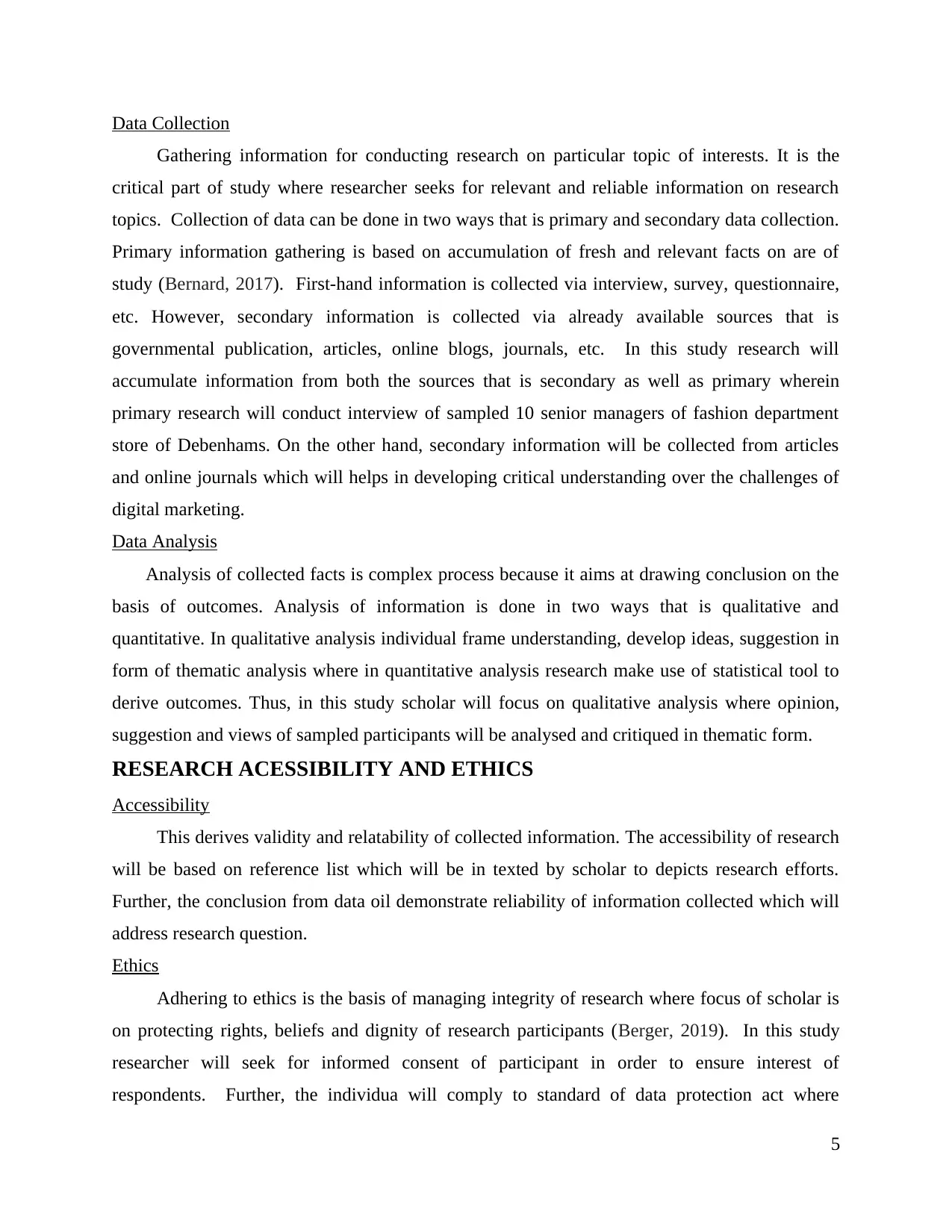
Data Collection
Gathering information for conducting research on particular topic of interests. It is the
critical part of study where researcher seeks for relevant and reliable information on research
topics. Collection of data can be done in two ways that is primary and secondary data collection.
Primary information gathering is based on accumulation of fresh and relevant facts on are of
study (Bernard, 2017). First-hand information is collected via interview, survey, questionnaire,
etc. However, secondary information is collected via already available sources that is
governmental publication, articles, online blogs, journals, etc. In this study research will
accumulate information from both the sources that is secondary as well as primary wherein
primary research will conduct interview of sampled 10 senior managers of fashion department
store of Debenhams. On the other hand, secondary information will be collected from articles
and online journals which will helps in developing critical understanding over the challenges of
digital marketing.
Data Analysis
Analysis of collected facts is complex process because it aims at drawing conclusion on the
basis of outcomes. Analysis of information is done in two ways that is qualitative and
quantitative. In qualitative analysis individual frame understanding, develop ideas, suggestion in
form of thematic analysis where in quantitative analysis research make use of statistical tool to
derive outcomes. Thus, in this study scholar will focus on qualitative analysis where opinion,
suggestion and views of sampled participants will be analysed and critiqued in thematic form.
RESEARCH ACESSIBILITY AND ETHICS
Accessibility
This derives validity and relatability of collected information. The accessibility of research
will be based on reference list which will be in texted by scholar to depicts research efforts.
Further, the conclusion from data oil demonstrate reliability of information collected which will
address research question.
Ethics
Adhering to ethics is the basis of managing integrity of research where focus of scholar is
on protecting rights, beliefs and dignity of research participants (Berger, 2019). In this study
researcher will seek for informed consent of participant in order to ensure interest of
respondents. Further, the individua will comply to standard of data protection act where
5
Gathering information for conducting research on particular topic of interests. It is the
critical part of study where researcher seeks for relevant and reliable information on research
topics. Collection of data can be done in two ways that is primary and secondary data collection.
Primary information gathering is based on accumulation of fresh and relevant facts on are of
study (Bernard, 2017). First-hand information is collected via interview, survey, questionnaire,
etc. However, secondary information is collected via already available sources that is
governmental publication, articles, online blogs, journals, etc. In this study research will
accumulate information from both the sources that is secondary as well as primary wherein
primary research will conduct interview of sampled 10 senior managers of fashion department
store of Debenhams. On the other hand, secondary information will be collected from articles
and online journals which will helps in developing critical understanding over the challenges of
digital marketing.
Data Analysis
Analysis of collected facts is complex process because it aims at drawing conclusion on the
basis of outcomes. Analysis of information is done in two ways that is qualitative and
quantitative. In qualitative analysis individual frame understanding, develop ideas, suggestion in
form of thematic analysis where in quantitative analysis research make use of statistical tool to
derive outcomes. Thus, in this study scholar will focus on qualitative analysis where opinion,
suggestion and views of sampled participants will be analysed and critiqued in thematic form.
RESEARCH ACESSIBILITY AND ETHICS
Accessibility
This derives validity and relatability of collected information. The accessibility of research
will be based on reference list which will be in texted by scholar to depicts research efforts.
Further, the conclusion from data oil demonstrate reliability of information collected which will
address research question.
Ethics
Adhering to ethics is the basis of managing integrity of research where focus of scholar is
on protecting rights, beliefs and dignity of research participants (Berger, 2019). In this study
researcher will seek for informed consent of participant in order to ensure interest of
respondents. Further, the individua will comply to standard of data protection act where
5
Paraphrase This Document
Need a fresh take? Get an instant paraphrase of this document with our AI Paraphraser
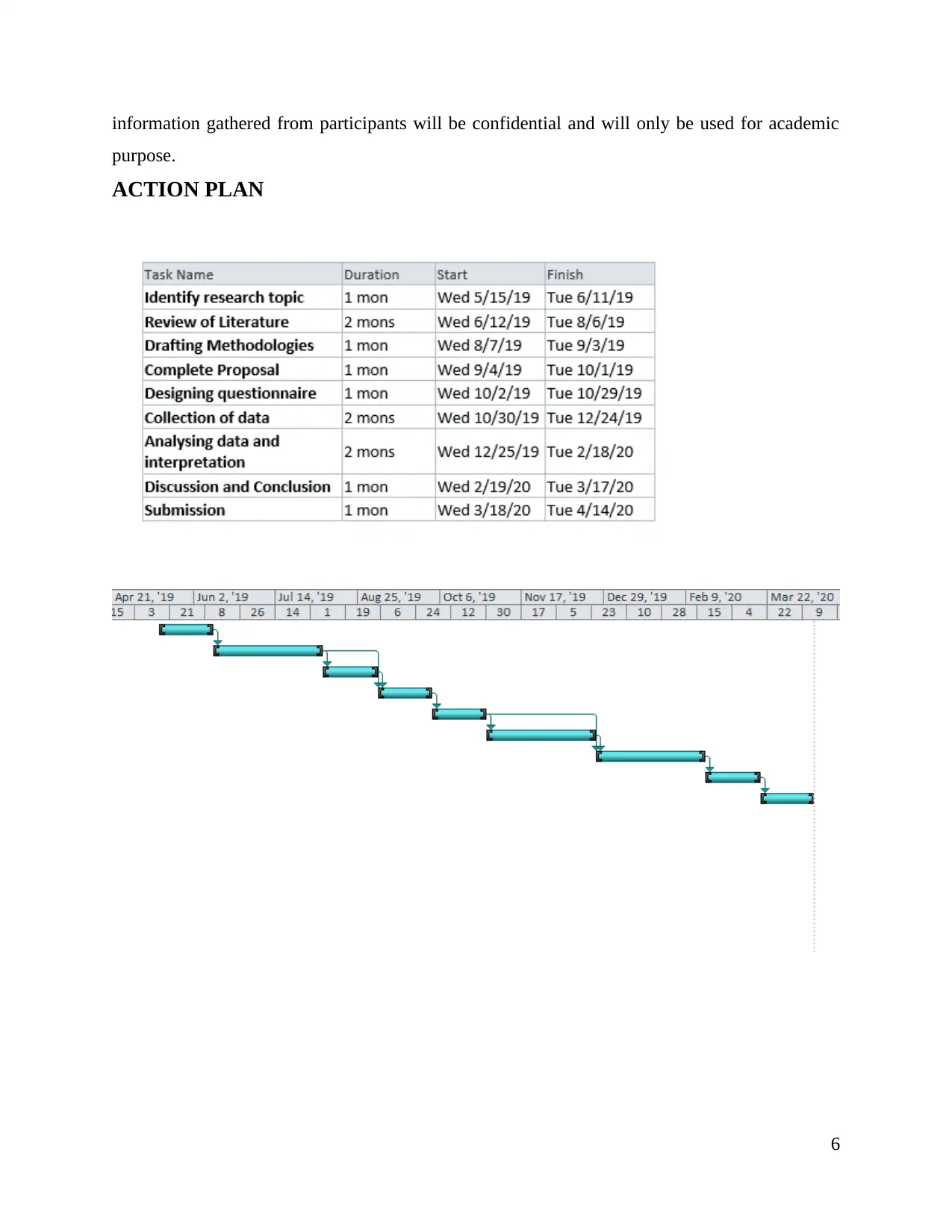
information gathered from participants will be confidential and will only be used for academic
purpose.
ACTION PLAN
6
purpose.
ACTION PLAN
6
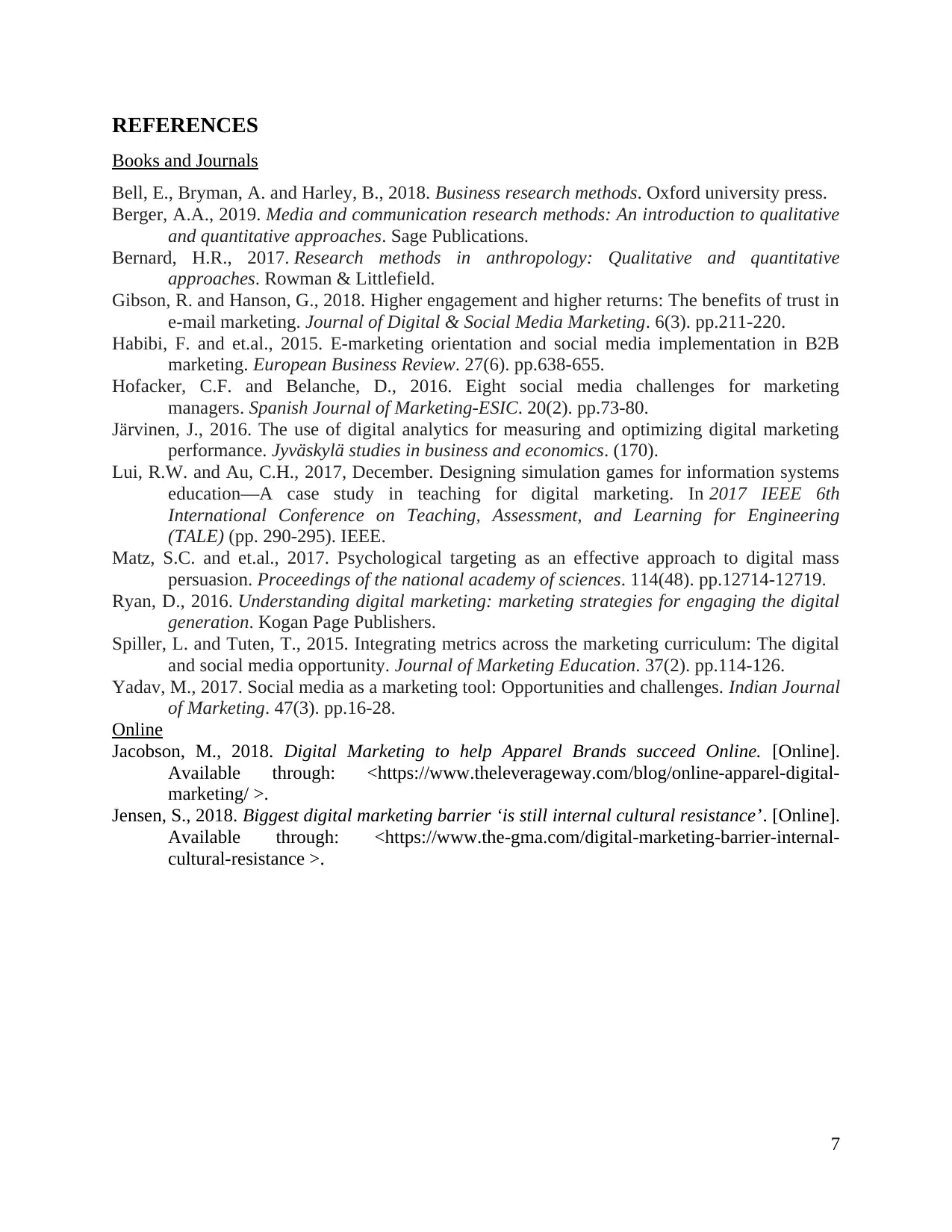
REFERENCES
Books and Journals
Bell, E., Bryman, A. and Harley, B., 2018. Business research methods. Oxford university press.
Berger, A.A., 2019. Media and communication research methods: An introduction to qualitative
and quantitative approaches. Sage Publications.
Bernard, H.R., 2017. Research methods in anthropology: Qualitative and quantitative
approaches. Rowman & Littlefield.
Gibson, R. and Hanson, G., 2018. Higher engagement and higher returns: The benefits of trust in
e-mail marketing. Journal of Digital & Social Media Marketing. 6(3). pp.211-220.
Habibi, F. and et.al., 2015. E-marketing orientation and social media implementation in B2B
marketing. European Business Review. 27(6). pp.638-655.
Hofacker, C.F. and Belanche, D., 2016. Eight social media challenges for marketing
managers. Spanish Journal of Marketing-ESIC. 20(2). pp.73-80.
Järvinen, J., 2016. The use of digital analytics for measuring and optimizing digital marketing
performance. Jyväskylä studies in business and economics. (170).
Lui, R.W. and Au, C.H., 2017, December. Designing simulation games for information systems
education—A case study in teaching for digital marketing. In 2017 IEEE 6th
International Conference on Teaching, Assessment, and Learning for Engineering
(TALE) (pp. 290-295). IEEE.
Matz, S.C. and et.al., 2017. Psychological targeting as an effective approach to digital mass
persuasion. Proceedings of the national academy of sciences. 114(48). pp.12714-12719.
Ryan, D., 2016. Understanding digital marketing: marketing strategies for engaging the digital
generation. Kogan Page Publishers.
Spiller, L. and Tuten, T., 2015. Integrating metrics across the marketing curriculum: The digital
and social media opportunity. Journal of Marketing Education. 37(2). pp.114-126.
Yadav, M., 2017. Social media as a marketing tool: Opportunities and challenges. Indian Journal
of Marketing. 47(3). pp.16-28.
Online
Jacobson, M., 2018. Digital Marketing to help Apparel Brands succeed Online. [Online].
Available through: <https://www.theleverageway.com/blog/online-apparel-digital-
marketing/ >.
Jensen, S., 2018. Biggest digital marketing barrier ‘is still internal cultural resistance’. [Online].
Available through: <https://www.the-gma.com/digital-marketing-barrier-internal-
cultural-resistance >.
7
Books and Journals
Bell, E., Bryman, A. and Harley, B., 2018. Business research methods. Oxford university press.
Berger, A.A., 2019. Media and communication research methods: An introduction to qualitative
and quantitative approaches. Sage Publications.
Bernard, H.R., 2017. Research methods in anthropology: Qualitative and quantitative
approaches. Rowman & Littlefield.
Gibson, R. and Hanson, G., 2018. Higher engagement and higher returns: The benefits of trust in
e-mail marketing. Journal of Digital & Social Media Marketing. 6(3). pp.211-220.
Habibi, F. and et.al., 2015. E-marketing orientation and social media implementation in B2B
marketing. European Business Review. 27(6). pp.638-655.
Hofacker, C.F. and Belanche, D., 2016. Eight social media challenges for marketing
managers. Spanish Journal of Marketing-ESIC. 20(2). pp.73-80.
Järvinen, J., 2016. The use of digital analytics for measuring and optimizing digital marketing
performance. Jyväskylä studies in business and economics. (170).
Lui, R.W. and Au, C.H., 2017, December. Designing simulation games for information systems
education—A case study in teaching for digital marketing. In 2017 IEEE 6th
International Conference on Teaching, Assessment, and Learning for Engineering
(TALE) (pp. 290-295). IEEE.
Matz, S.C. and et.al., 2017. Psychological targeting as an effective approach to digital mass
persuasion. Proceedings of the national academy of sciences. 114(48). pp.12714-12719.
Ryan, D., 2016. Understanding digital marketing: marketing strategies for engaging the digital
generation. Kogan Page Publishers.
Spiller, L. and Tuten, T., 2015. Integrating metrics across the marketing curriculum: The digital
and social media opportunity. Journal of Marketing Education. 37(2). pp.114-126.
Yadav, M., 2017. Social media as a marketing tool: Opportunities and challenges. Indian Journal
of Marketing. 47(3). pp.16-28.
Online
Jacobson, M., 2018. Digital Marketing to help Apparel Brands succeed Online. [Online].
Available through: <https://www.theleverageway.com/blog/online-apparel-digital-
marketing/ >.
Jensen, S., 2018. Biggest digital marketing barrier ‘is still internal cultural resistance’. [Online].
Available through: <https://www.the-gma.com/digital-marketing-barrier-internal-
cultural-resistance >.
7
⊘ This is a preview!⊘
Do you want full access?
Subscribe today to unlock all pages.

Trusted by 1+ million students worldwide
1 out of 9
Related Documents
Your All-in-One AI-Powered Toolkit for Academic Success.
+13062052269
info@desklib.com
Available 24*7 on WhatsApp / Email
![[object Object]](/_next/static/media/star-bottom.7253800d.svg)
Unlock your academic potential
Copyright © 2020–2025 A2Z Services. All Rights Reserved. Developed and managed by ZUCOL.





